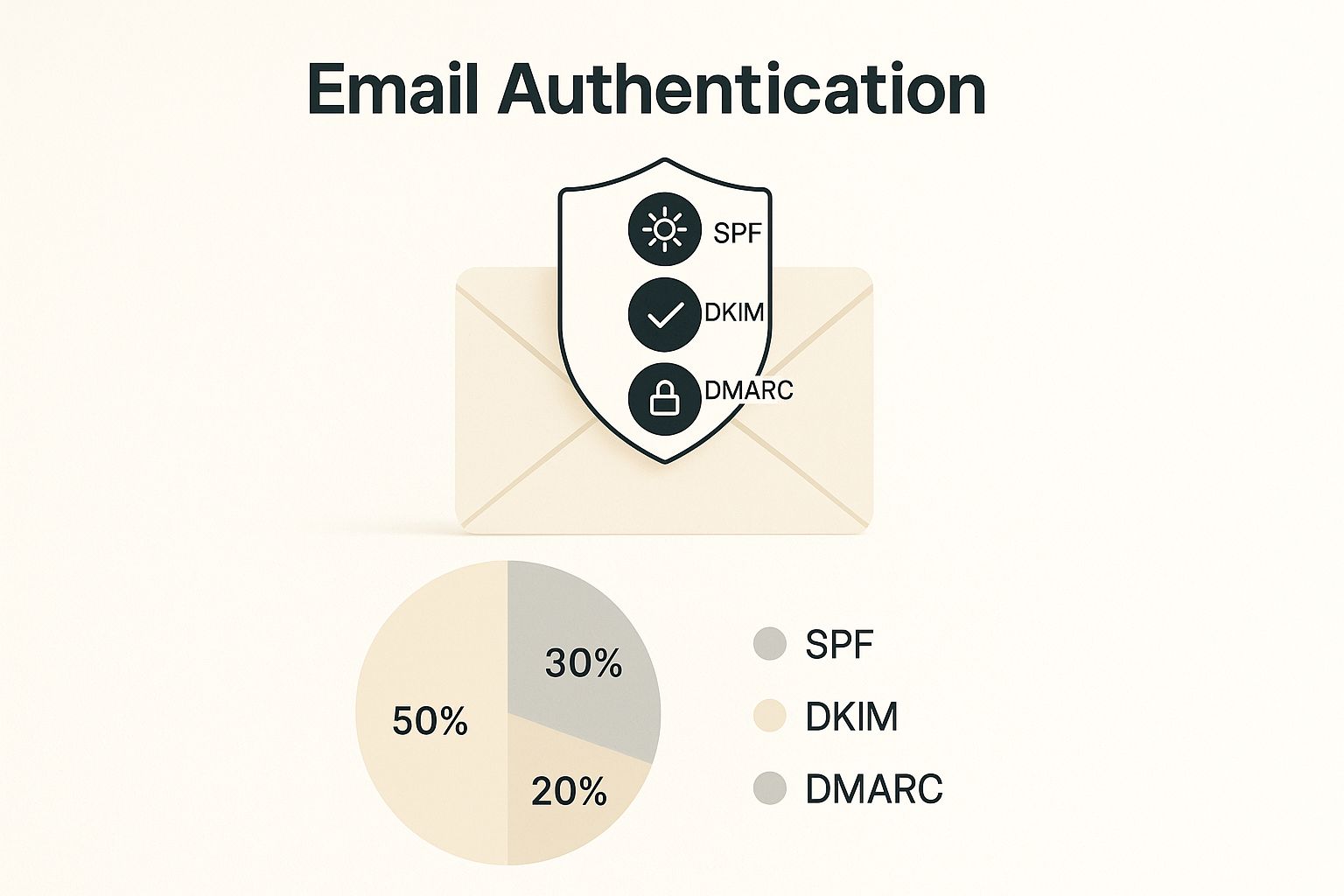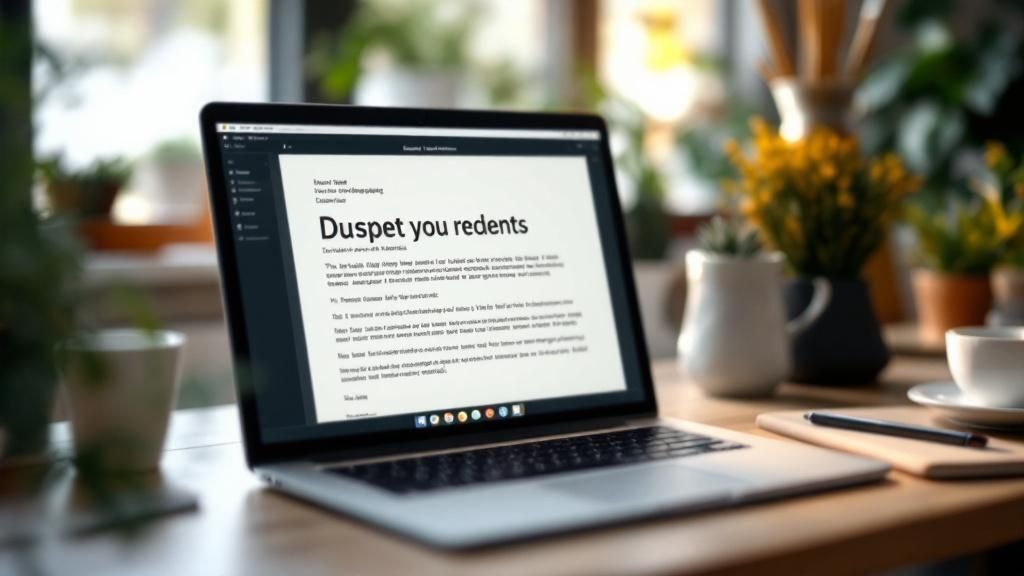Email Deliverability Fundamentals That Actually Matter
Improving email deliverability is crucial for any successful email marketing strategy. It's not just about hitting "send"; it's about ensuring your messages reach the inbox, not the spam folder. This involves understanding the core principles that determine your email's fate. A significant development in recent years is the rise of AI-powered spam filters, constantly evolving and learning to detect unwanted emails. This makes traditional deliverability tactics less effective, necessitating a more sophisticated approach. For startups, a strong foundation in digital marketing for startups is key.
Understanding The Importance of Deliverability
Why is deliverability so important? It's the gatekeeper to your audience. Low deliverability means your carefully crafted messages go unseen, making your email marketing efforts pointless. This leads to missed opportunities, diminished ROI, and a negative impact on your bottom line. Furthermore, consistently low deliverability can harm your sender reputation, making it harder to reach the inbox in the future.
This is particularly crucial given the sheer volume of emails sent and received daily. In 2022, an estimated 333 billion emails were sent and received each day. This number is projected to reach almost 392.5 billion by 2025. You can find more detailed statistics here. This enormous volume emphasizes the importance of optimizing your emails for deliverability to stand out and reach your intended recipients.
Key Factors Influencing Email Deliverability
Several critical elements contribute to your overall deliverability score. Authentication is crucial, proving to email providers that you're a legitimate sender. This involves implementing protocols like SPF, DKIM, and DMARC. These act as digital signatures, verifying your identity and protecting your brand from spoofing.
Your sender reputation is another vital factor. It’s a score assigned by email providers based on your sending habits. A good sender reputation signals trustworthiness, boosting your chances of reaching the inbox.
Building A Strong Foundation For Long-Term Success
Improving email deliverability isn't a one-time fix; it's a continuous process of optimization and adaptation. This involves regularly monitoring your email metrics, such as bounce rates, spam complaints, and open rates. Analyzing this data helps identify areas for improvement and refine your strategies.
Maintaining a clean and engaged email list is also paramount. Regularly removing inactive subscribers improves your metrics and demonstrates to email providers that you are sending to a receptive audience.
By understanding and applying these fundamental principles, you can significantly improve your email deliverability, ensuring your messages reach your target audience. This creates a foundation for successful email marketing that drives engagement, generates leads, and ultimately, achieves your business objectives.
Authentication Protocols That Unlock Better Deliverability

This infographic illustrates how the core email authentication protocols—SPF, DKIM, and DMARC—work together. They create a protective layer around your emails, ensuring safe arrival in the inbox. Much like a knight's shield, these protocols guard your messages, boosting your sender reputation and enhancing your overall deliverability. This highlights the importance of implementing all three for complete email protection.
Getting your emails to the inbox hinges on email authentication. This process confirms your sender identity, assuring email providers your messages are legitimate and not spam. Think of it as a digital signature, validating the origin of your emails and shielding your brand from impersonators. Strong authentication drastically reduces the risk of your emails being marked as spam or phishing attempts. This builds trust with email providers and strengthens your sender reputation.
SPF: Verifying Your Sending Servers
Sender Policy Framework (SPF) acts as your first line of defense. It's a DNS record that lists the mail servers authorized to send emails on your domain's behalf. This helps prevent spoofing, where bad actors forge your domain for fraudulent emails. SPF enables email providers to easily identify and block unauthorized senders, protecting both you and your recipients.
DKIM: Ensuring Message Integrity
DomainKeys Identified Mail (DKIM) provides an extra layer of security by digitally signing your emails. This signature confirms the email content hasn't been tampered with during transit. If someone tries to alter your message after it's sent, DKIM detects the change and alerts the recipient. This guarantees message integrity, reinforcing your credibility.
DMARC: Enforcing Your Policies
Domain-based Message Authentication, Reporting & Conformance (DMARC) is the final, crucial component. It connects SPF and DKIM, giving you control over how email providers handle messages that fail authentication. You can instruct providers to quarantine suspicious emails, mark them as spam, or even reject them entirely. The 2025 Email Deliverability Benchmark Report by Validity emphasizes the growing importance of DMARC. Its adoption is critical for protecting brand identity and improving deliverability, especially given declining global inbox placement rates due to stricter mailbox provider requirements.
To help clarify the differences and relationships between these protocols, let’s take a closer look at the following table:
Email Authentication Protocol Comparison
This table compares SPF, DKIM, and DMARC, highlighting their functions, implementation difficulty, and impact on deliverability.
| Protocol | Primary Function | Setup Complexity | Deliverability Impact | Required for DMARC |
|---|---|---|---|---|
| SPF | Authorizes sending mail servers | Relatively simple | Moderate | No, but recommended |
| DKIM | Digitally signs emails to verify integrity | Moderate | Significant | No, but recommended |
| DMARC | Defines how to handle emails that fail SPF and/or DKIM checks | More complex | Highest | Yes, SPF and/or DKIM are prerequisites |
As you can see, while each protocol has its own focus, they work best together. DMARC relies on the foundation laid by SPF and DKIM.
The Power of Combined Authentication
Using all three protocols—SPF, DKIM, and DMARC—builds a robust defense against spoofing and phishing. This drastically improves your email deliverability. This combined approach safeguards your brand reputation and ensures your messages reach your target audience, maximizing the impact of your email marketing. DMARC, in particular, is essential for email marketers striving to maintain high deliverability and protect their brand.
Building Your Sender Reputation The Right Way

Your sender reputation is crucial for email marketing success. It determines whether Internet Service Providers (ISPs) trust your messages and deliver them to inboxes, acting as a gatekeeper for your campaigns. Building and maintaining a positive sender reputation is essential for long-term success.
Key Metrics That Impact Your Sender Score
Several metrics influence your sender reputation, each contributing to your overall trustworthiness in the eyes of ISPs.
Engagement rates, like opens and clicks, show that your audience finds your content valuable. High engagement indicates relevant content reaching the right people. Low engagement, on the other hand, might suggest issues with your content or targeting.
Complaint rates are a serious concern. If many recipients mark your emails as spam, your reputation will suffer. This tells ISPs that your messages are unwanted. Bounce percentages, particularly hard bounces from invalid email addresses, also negatively impact your score. High bounce rates point to poor list management.
Warm-Up Strategies for New Domains and IPs
New domains and IP addresses need a warm-up period to build trust with ISPs. Start by sending a low volume of emails and gradually increase it over a few weeks. This allows ISPs to recognize you as a legitimate sender. A gradual increase avoids sudden spikes in email activity that can trigger spam filters. It's like building a relationship, proving your trustworthiness over time.
Optimizing Engagement, Complaints, and Bounces
Improving these metrics requires a strategic approach.
- Engagement: Focus on valuable, personalized content. Segment your email list to ensure relevance.
- Complaints: Make unsubscribing easy and honor opt-out requests immediately. Review your content for spam triggers and ensure it aligns with recipient expectations.
- Bounces: Regularly clean your list and remove invalid addresses. Verify addresses at signup to prevent errors. Use a double opt-in process to confirm subscriber interest. For further insights on lead generation, check out How to master B2B sales lead generation.
Reputation Recovery: Bouncing Back From Deliverability Disasters
Even with best practices, deliverability problems can occur. If your sender reputation suffers, identify the root cause. Implement corrective actions, like improving list hygiene or revising content. Monitor your metrics to track progress. Recovery takes time and consistent effort. By understanding and addressing these factors, you can ensure your emails reach the inbox, build stronger audience relationships, and achieve your marketing goals.
Geographic Strategies That Maximize Global Reach

Creating a successful email campaign isn't just about compelling content. It's about understanding your global audience. Generic, one-size-fits-all approaches don't work in today's diverse marketplace. Savvy marketers understand the power of geographic segmentation, tailoring their strategies to different regions. This means considering regional preferences in everything from commonly used email clients to cultural expectations. The payoff? Higher open rates, better engagement, and a stronger return on investment.
Regional Differences in Email Deliverability
Email deliverability varies significantly across the globe. These regional differences have a direct impact on your campaign's performance in different markets. For instance, Europe generally enjoys high inbox placement rates. This suggests strong sender reputation and audience engagement. However, other regions, like the Asia-Pacific region, often face deliverability hurdles due to stricter spam filters and varied internet infrastructure.
Understanding the unique landscape of each target region is crucial. Current data (2024-2025) reveals significant regional variations in email deliverability. Europe leads with inbox placement rates around 91%. The Asia-Pacific (APAC) region reports the lowest average, around 78%. North America and Latin America fall somewhere in between, with mid-to-upper 80% inbox placement. For a deeper dive into this topic, explore this resource: Mastering Global Email Deliverability in 2024-2025. Armed with this knowledge, you can create targeted strategies optimized for each region.
Adapting Your Approach for Global Success
Global email marketing success hinges on adapting your strategies to each region's specific needs. Several key factors come into play. Send times, for example, should be optimized for local time zones to maximize opens. Content should resonate with the local culture and preferences. And authentication strategies must comply with regional regulations and internet service provider (ISP) requirements.
Optimizing for Specific Regions
Here are some specific tactics to improve deliverability in key regions:
- Europe: Focus on GDPR compliance and data privacy. Offer clear opt-in and opt-out options.
- North America: Segment audiences by location, industry, and engagement. Personalize content for specific demographics.
- Asia-Pacific: Adapt messaging to the diverse languages and cultural nuances. Keep subject lines concise and avoid spam triggers.
- Latin America: Build relationships with local ISPs and understand their requirements. Use localized templates and translated content.
To illustrate these regional variations and best practices, let's take a look at the following table:
Global Inbox Placement Rates by Region
| Region | Average Inbox Rate | Top Performing Country | Key Challenges | Recommended Strategy |
|---|---|---|---|---|
| Europe | 91% | Germany | GDPR Compliance | Prioritize data privacy and clear opt-in/out |
| North America | 85% | United States | High competition | Personalization and segmentation |
| Asia-Pacific | 78% | Japan | Strict spam filters, diverse languages | Localized messaging, concise subject lines |
| Latin America | 82% | Brazil | ISP relationships | Localized templates, translated content |
This table highlights key differences in inbox placement rates and the challenges unique to each region. By understanding these nuances, marketers can tailor their strategies for optimal results.
By understanding each region’s unique characteristics and applying these targeted strategies, you can significantly expand your global reach and enhance email deliverability worldwide.
List Management Strategies That Boost Performance
A clean, engaged email list is essential for good email deliverability. However, many marketers struggle with maintaining a healthy list. A pristine email list is crucial. For a deeper dive into its importance, check out Why Verify a List. This section will cover effective list management strategies that can significantly boost your email performance and maintain healthy list growth. This involves proactively identifying and addressing problematic subscribers before they impact your sender reputation.
Identifying and Addressing Problematic Subscribers
One of the first steps in effective list management is identifying problematic subscribers. These are the individuals who negatively impact your sender reputation and lower deliverability rates. Look for subscribers with consistently low engagement, repeated bounces, or multiple spam complaints. These are all red flags that require prompt action. For instance, if a subscriber hasn't opened your emails in six months, they are probably inactive and potentially harming your metrics.
Addressing these issues can take several forms. You could implement a re-engagement campaign to try and win back inactive subscribers. This might include sending a special offer or simply asking them to update their email preferences.
If a subscriber consistently bounces or marks your emails as spam, it's best to remove them from your list. This might seem counterintuitive, but a smaller, engaged list is more valuable than a large, inactive one.
Re-Engagement Campaigns That Work
Effective re-engagement campaigns are more than just another email. They offer genuine value and remind subscribers why they joined your list. Craft compelling subject lines and offer content that aligns with their interests. Consider a discount, exclusive content, or even a personalized message acknowledging their lack of recent engagement.
Not all re-engagement efforts will be successful. Some subscribers will stay inactive. This is where suppression list management comes into play. Move these inactive subscribers to a separate suppression list to exclude them from future campaigns. This helps maintain a clean list and safeguards your sender reputation. For more sales strategies, you might find this helpful: How to master the inbound sales funnel.
Advanced Segmentation for Improved Engagement
Segmentation is a powerful tool for improving engagement and deliverability. Divide your list into smaller, more focused groups to send relevant content that resonates with each subscriber’s specific interests. Segmentation also allows you to personalize your messaging, further increasing engagement and reducing the likelihood of complaints and unsubscribes.
This, in turn, improves your sender reputation and boosts deliverability rates. Think of it as tailoring your communication, rather than sending a generic message.
Automation Strategies for List Hygiene
Maintaining a healthy email list doesn’t require manual effort. Implementing automated hygiene processes streamlines list management and saves you valuable time. Set up automated workflows to remove inactive subscribers, manage bounces, and update suppression lists. This ensures consistent list hygiene without constant manual intervention. These automated systems operate much like a self-cleaning oven, continually maintaining peak performance. By implementing these strategies, you can build a robust list management system that strengthens deliverability and drives improved results from your email marketing.
Content And Timing Optimization For Inbox Success
Even with perfect email authentication, poorly written content can land your message in the spam folder. Modern spam filters are complex, analyzing many aspects of your emails to determine their legitimacy. To improve your email deliverability, you must understand what these filters are looking for and create emails that engage your audience while also meeting algorithmic requirements. This involves writing compelling subject lines that avoid spam triggers, structuring your emails effectively, and balancing promotional content with valuable information. Timing also plays a crucial role. Optimizing send times based on audience engagement data can dramatically increase your inbox placement rates.
Crafting Compelling Subject Lines
Your subject line is the first impression. It's the gatekeeper to your email's content, deciding whether recipients open your message or delete it. Avoid overusing capital letters, exclamation points, or spam-triggering words like "free" or "guaranteed." Focus instead on clarity and value, clearly stating the email's purpose and enticing recipients to open it. A/B testing subject lines can help you identify which approaches work best for your audience.
Structuring Your Emails for Success
Email structure is important for both readability and deliverability. Use a clear and concise layout with headings, bullet points, and short paragraphs to make your content digestible. Ensure your emails are mobile-friendly, since many people read their email on their phones. Balance text and images carefully. Too many images can trigger spam filters, while too much text can be overwhelming for readers.
Balancing Promotional Content
While promotional emails are crucial for marketing, avoid overly aggressive sales techniques. Balance promotional content with valuable information such as industry insights, helpful tips, or educational resources. This adds value for your recipients and positions you as a helpful resource rather than just a salesperson. You might be interested in: How to master cold email templates for sales. This approach builds trust and encourages engagement, which has a positive impact on deliverability.
Timing Your Emails for Maximum Impact
Sending emails at the right time can significantly boost your open and click-through rates. The best send time will depend on your audience and industry. Analyze your email engagement data to identify trends and determine when your subscribers are most active. Experiment with different send times and track the results to find the optimal time for your audience. Tools like Salesloop.io can help automate this process, ensuring your messages arrive at times that maximize engagement.
Analyzing High-Performing Campaigns
Learning from successful campaigns is essential for improving your own email deliverability. Analyze your high-performing emails to identify common elements like subject line strategies, content balance, and call-to-action placement. Apply these best practices to your own campaigns and track the impact. This data-driven approach allows you to constantly refine your strategy and improve your inbox placement rates. By following these strategies, you can ensure your emails reach their intended recipients and contribute to your overall marketing success.
Monitoring And Improvement Systems That Work
Improving email deliverability isn't a set-it-and-forget-it task. It requires ongoing monitoring and optimization, much like tending a garden. You can't just plant seeds and walk away; you need to water, weed, and nurture them for growth. Similarly, healthy email deliverability demands continuous attention and adjustments. This section will explore vital metrics, monitoring tools, and improvement systems to keep your emails landing in the inbox.
Essential Metrics and Monitoring Tools
Tracking the right metrics offers critical insights into your email program's effectiveness. Key metrics to watch include:
-
Delivery Rates: The percentage of emails accepted by recipient servers. This baseline metric reveals whether your emails are even reaching their intended destination.
-
Inbox Placement Rates: Going beyond basic delivery, this metric measures the percentage of emails landing in the inbox, not spam or junk folders.
-
Bounce Rates: The percentage of undelivered emails. Hard bounces signal permanent failures (like an invalid address), while soft bounces are temporary (such as a full inbox).
-
Spam Complaint Rates: The percentage of recipients marking your emails as spam. A high complaint rate is a serious warning sign.
-
Open and Click-Through Rates: While not direct deliverability metrics, these engagement indicators influence how Internet Service Providers (ISPs) view your emails. Higher engagement suggests valuable content, boosting your sender reputation.
Several tools can help monitor these metrics. Some Email Service Providers (ESPs) offer built-in analytics dashboards. Third-party deliverability tools like Mail-Tester offer more advanced tracking and analysis across various ISPs. The best tool for you depends on your individual needs and budget.
Setting Up Effective Alert Systems
Real-time alerts notify you of potential deliverability problems as they happen. These alerts act as an early warning system, giving you a heads-up before small issues become big problems. Set up alerts for sudden drops in delivery rates, spikes in bounce rates, or increases in spam complaints. This proactive approach allows you to identify and fix problems before they seriously impact your campaigns. For example, a sudden surge in bounces could indicate a list problem or a technical issue with your sending server. A prompt alert allows for swift corrective action.
Testing and Optimization Methodologies
Regular testing helps identify and optimize aspects of your email program. Test different send times to determine peak audience engagement. Experiment with content variations, subject lines, and calls to action. A/B testing offers valuable data on which strategies best resonate with your subscribers. This data-driven approach allows for continuous campaign improvement and maximizes inbox placement rates. You could test two different subject lines, for example, to see which generates more opens.
Deliverability Audits and Benchmarking
Regular deliverability audits assess your overall email health and pinpoint areas for improvement. These audits function like regular checkups for your email program, evaluating authentication protocols, sender reputation, list hygiene, and content strategies. Benchmark your performance against industry standards to understand your strengths and weaknesses. This creates a roadmap for continuous optimization and helps you stay ahead of evolving deliverability challenges.
By implementing these monitoring and improvement systems, you can proactively manage your email deliverability, ensuring your messages reach the intended audience and deliver the results you expect. Consistent care and optimization will cultivate engaged subscribers and successful campaigns.
Ready to enhance your sales outreach and improve deliverability? Discover how Salesloop.io can help you reach the inbox and drive more conversions.





